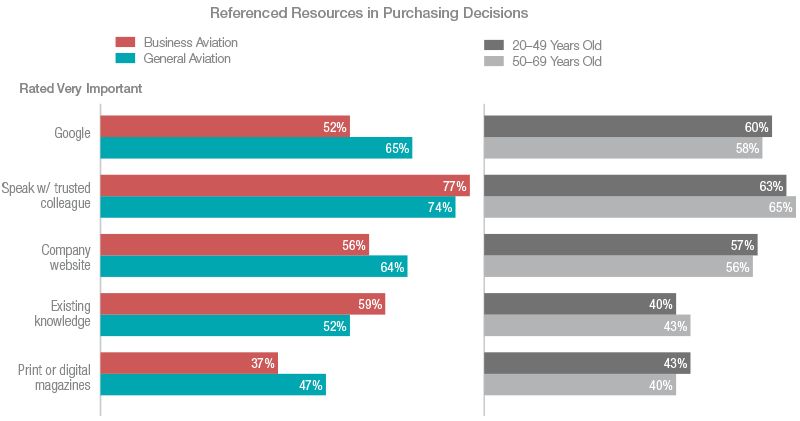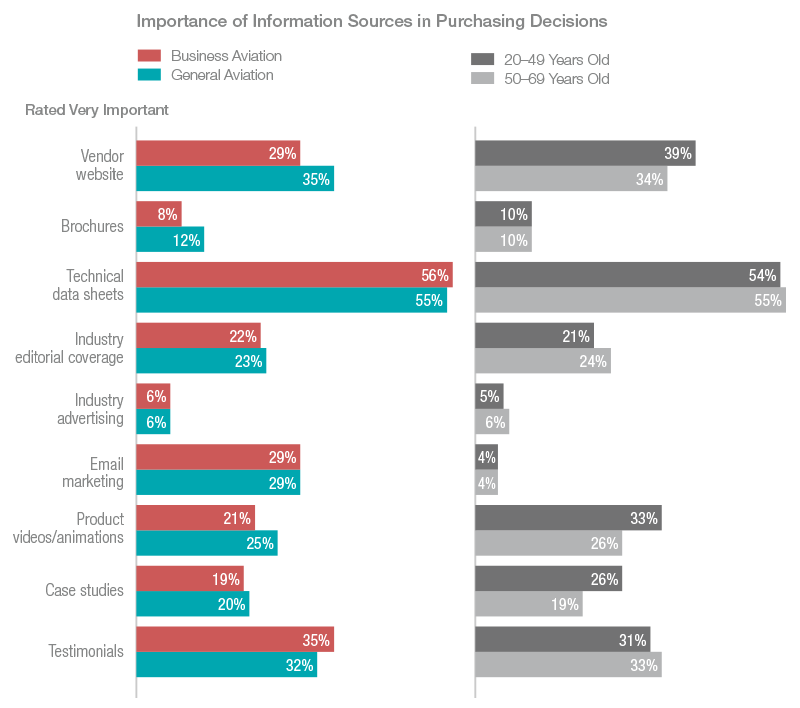How to market and sell to GA and BA audiences
This final installment in our series on purchasing behavior in General Aviation (GA) and Business Aviation (BA) seeks to better understand the marketing tactics that are likely to be most effective with these audiences.
We asked respondents to rate the importance of various information sources they may reference during the decision-making process and were surprised to learn that technical data sheets are strongly favored, regardless of age or market segment. Fifty-six percent of respondents consider data sheets very important, and an additional 35% see them as moderately important — that’s 91% of respondents.
Regardless of age or market, respondents also value testimonials, vendor websites and product video/animations, but industry advertising ranks dead last with all groups surveyed.
How much of your marketing budget is devoted to advertising or brochures? If you are spending a significant amount on these items it might be time to reconsider and reallocate to other resources that buyers find more important.
Who, among human information sources is least valued? Sales reps. Only 9% on average consider sales reps very important. In-person demos or other direct experience rates the highest, followed closely by industry contacts and friends. Distributors or dealers and trade shows fare only slightly better than sales reps. We were most surprised by the rather mediocre performance of trade shows, especially with the BA respondents, who also place greater value on their industry contacts and friends than do the GA respondents.

It turns out that no one, regardless of age or market segment, wants to be sold, either by sales reps, or dealers, or at trade shows. This tells us that an inbound marketing approach, where businesses draw customers to them by providing helpful content (and not sales pitches), could have great utility and value for aviation marketers.
We also asked respondents what resources they refer to during their consideration and evaluation process prior to making a purchase. All respondents prefer to speak with trusted colleagues over Google searches and referencing company websites. BA respondents place more value on their existing knowledge, while print and digital magazines rank last with everyone.
But when you whittle down those choices and ask respondents to pick just one resource, speaking with trusted colleagues is picked 43% of the time, followed by a big drop to 14% using Google, then about a 50% drop to the other “top” choices such as website, existing knowledge and magazines.

As we keep seeing throughout this series, people trust their own experiences and the opinions of friends and colleagues; performance is king; brands are not important; and no one wants to be sold.
For marketers, the keys to the kingdom are in finding ways to allow more people to use the product/service and then turn those users into unpaid evangelists. Work hard to make non-sales-y, factual and data-driven information available via multiple channels, including the web. And look carefully at the investment being made in trade shows, brochures and advertising. You may find it wise to re-allocate some of those funds to product demos, content marketing or referral programs.
To learn more about buying behavior in GA and BA, reference the other blogs in this series here and here. To subscribe to this blog and enjoy weekly email delivery, click here.
To approach your marketing in a more strategic fashion, download this easy-to-use marketing planner. It’s one of the most popular resources we offer.

